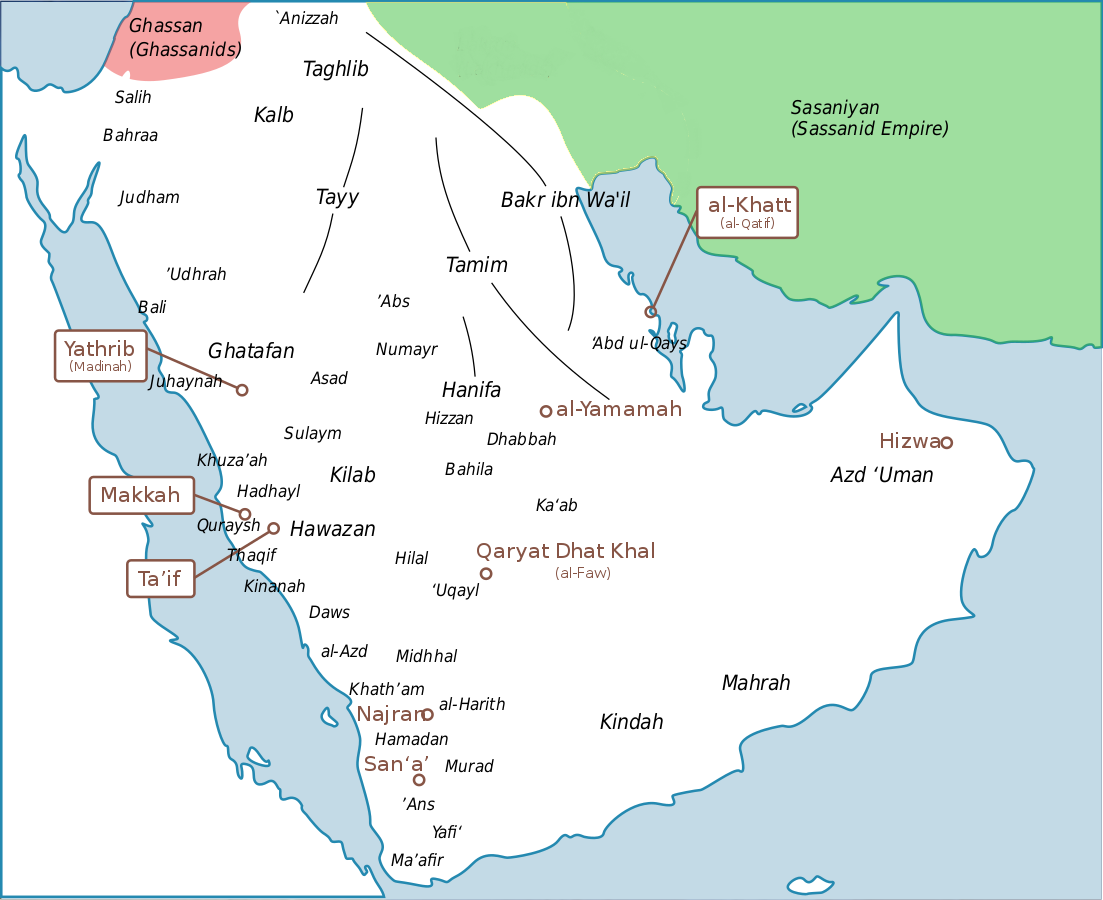The First Eight Years of Prophet Muhammad (peace be upon him)
Muslim History Series Article #2
After the birth of the Prophet Muhammad (peace be upon him), the first six years of his life were marked by early separation, physical hardship, and signs that would later become part of the proof of his mission. These were the years that shaped his body and soul before any message was revealed.
Where Is Banu Saʿd Located?
Banu Saʿd was a Bedouin sub-tribe of the larger Hawazan tribe. Their territory was located in the rural desert region east and southeast of Makkah, near the area of Ta’if. The map in this article shows the broader region of Hawazan, which is historically accurate for the tribe of Halimah, the foster mother of the Prophet Muhammad (s.a.w). While the name “Banu Saʿd” is not labeled directly, their location is included within that Hawazan region. Halimah brought the Prophet Muhammad (s.a.w) to this area during his early childhood, and he spent the first years of his life there in the care of her family. This was a banu sad tribe that mattered a lot to the early
Where Is Abwa?
Abwa is a small village located between Makkah and Yathrib (Madinah). It does not appear on most maps because of its small size and limited political importance. However, it holds deep significance in the life of the Prophet Muhammad (s.a.w). This is the place where his mother Aminah(a.s) passed away when he was six years old. Abwa’ lies along the traditional caravan route that travelers used to move between Makkah and Yathrib. On this map, it would fall roughly along the path connecting those two cities. While the village is not labeled, its historical location is confirmed in multiple seerah sources.
The Foster Tradition in Arabia
It was a common custom in Makkah for noble families to send their newborns to live with Bedouin tribes in the desert. The purpose was to raise children in a clean environment away from the diseases of the city. It also allowed them to develop strong bodies, a sharp tongue, and a pure dialect of Arabic. This tradition was especially important to the Quraysh, who saw linguistic purity as a marker of prestige.
The Prophet Muhammad (peace be upon him) was sent to live with the tribe of Banu Sa‘d, a well-known Bedouin tribe located outside of Makkah. The woman who became his foster mother was Halimah bint Abi Dhu’ayb. She came to Makkah with other nursing women hoping to find children from wealthy families. Most women rejected the Prophet Muhammad (s.a.w) because he was fatherless and would not bring financial reward.
Halimah had no other option. Every other child had been taken. Her husband convinced her to take the orphan child. She accepted reluctantly. On the way back to her tribe, she noticed changes that surprised her. Her donkey, which had been weak and slow, moved faster than all others. Her camel began producing milk again. Her own milk increased enough to feed both her baby and the Prophet Muhammad (s.a.w). These details are recorded in the seerah books of Ibn Hisham and Ibn Kathir. They are not found in the sahih hadith collections, but they were preserved by early historians as consistent reports.
Life with Halimah
The Prophet lived with Halimah and her family for approximately two years. During this time, her household witnessed unusual blessings. The animals became more productive. The pastures grew better than those of the surrounding tribes. Halimah and her husband knew this child was unlike the others. He did not cry excessively. He was quiet and observant. He was respectful even as a toddler.
When it came time to return him to his mother, Halimah requested to keep him longer. She wanted to continue raising him. Aminah(a.s) agreed. The Prophet (s.a.w) remained with Halimah for another one or two years.
The Chest-Opening Event
One day, while the Prophet Muhammad (s.a.w) was around four years old, he was playing outside in the fields with Halimah’s son. This was during the time he was living with his foster family in the desert area of Banu Sa’d. While they were playing, two unknown men dressed in white came toward him. They were not normal people. According to multiple authentic narrations, including (recorded in Sahih Muslim, Book 1, Hadith 318 — 162 c on Sunnah.com; also numbered Book 1, Hadith 311 in the older USC-MSA scheme) these two men were actually angels.
They took the Prophet Muhammad (s.a.w), laid him on the ground, and physically opened his chest. They took out his heart. Then, they removed a black clot from it. One of the angels said, “This is the portion of Shaytan in you.” After that, they washed the heart with Zamzam water, using a golden vessel, and then placed it back inside and closed his chest.
Keep reading with a 7-day free trial
Subscribe to VEINS OF TRUTH to keep reading this post and get 7 days of free access to the full post archives.


